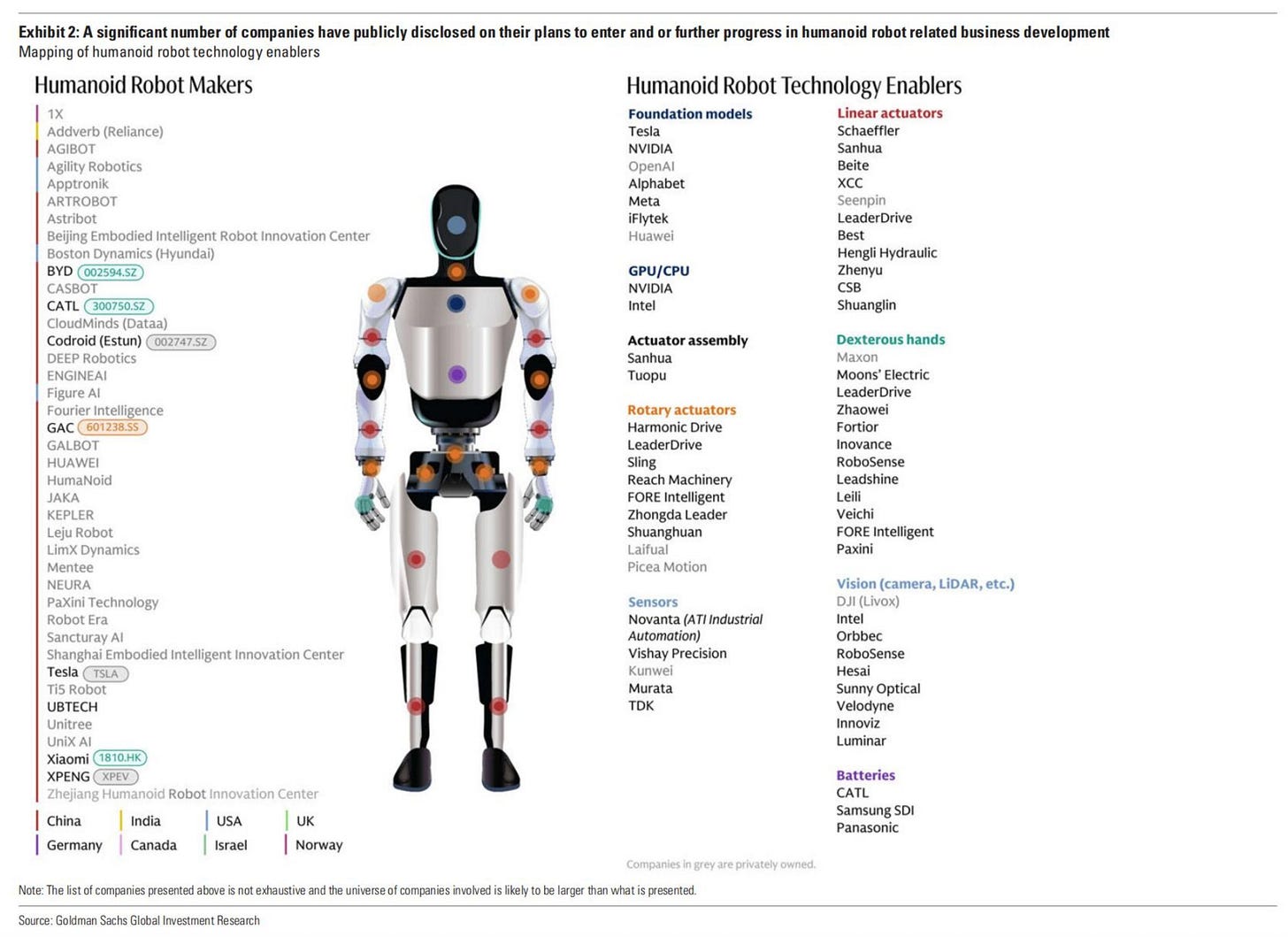The Evolving Robotics Ecosystem: Insights into the Humanoid Robot Supply Chain and Opportunities for Growth
At 13x.ai, we pride ourselves on being at the forefront of financing innovative robotics and automation solutions, empowering businesses to embrace the future of technology.
As the robotics ecosystem continues to expand, recent developments in the humanoid robot supply chain offer a compelling glimpse into the rapid evolution of this industry.
Today, we dive into a key analysis shared by semiconductor analyst Ray Wang on X, highlighting a Goldman Sachs chart that maps over 50 companies driving the humanoid robot revolution.
This insight underscores the growth of the supply chain, which is poised to accelerate product development, deployment, and adoption, areas where 13x.ai is uniquely positioned to support our ecosystem and corporate clients.
The chart categorises companies into “Humanoid Robot Makers” and “Ecosystem Enablers,” showcasing a global network of innovators. Prominent names include:
Humanoid Robot Makers: Tesla (TSLA), Figure AI, Agility Robotics, and Sanctuary AI, among others, are leading the charge in designing and building next-generation humanoid robots.
Ecosystem Enablers: Companies like Nvidia (NVDA) provide cutting-edge AI models, while Harmonic Drive and other specialists supply critical components such as actuators.
The chart also employs colour-coding to indicate the geographic origins of these companies, spanning the U.S., China, Japan, South Korea, and beyond. This visualisation highlights the collaborative and competitive nature of the robotics landscape, with significant contributions from both established tech giants and emerging players.
Market Growth and Investment Potential
Goldman Sachs’ research, as cited in the post, paints an optimistic picture for the humanoid robot market. The firm forecasts that the global market could reach $38 billion by 2035, a sixfold increase from earlier projections of $6 billion.
This growth is driven by advancements in AI, declining component costs, and the increasing demand for automation across industries such as manufacturing, logistics, and healthcare.
For businesses in our ecosystem, this trajectory signals a golden opportunity. The rapid scaling of the supply chain, encompassing everything from sensors and actuators to AI software, means faster product development cycles and more efficient deployment.
As humanoid robots transition from experimental prototypes to practical solutions, companies like those we finance at 13x.ai can capitalise on this momentum to bring innovative technologies to market.
Challenges and Opportunities in the Supply Chain
While the chart provides valuable insights, it has sparked lively discussion on X, with users pointing out potential inaccuracies. For instance, Tesla and Sanctuary AI, both North American companies, were mistakenly labelled as Chinese, prompting questions about the chart’s precision.
Additionally, respondents noted the omission of key South Korean suppliers, such as LG Innotek, which provides cameras for Figure AI’s F.02 and F.03 models, and other actuator manufacturers.
These oversights highlight the complexity of the global supply chain and the need for comprehensive data as the industry matures.
At 13x.ai, we see these discussions as an opportunity to refine our understanding of the ecosystem. By partnering with clients and leveraging our financing expertise, we can help bridge gaps in the supply chain, ensuring that emerging markets and overlooked innovators receive the support they need to thrive.
This collaborative approach will accelerate the adoption of humanoid robots, making them more accessible to a broader range of industries.
Why This Matters for Our Clients
The growth of the humanoid robot supply chain has direct implications for our corporate clients and the broader robotics community. Here’s how:
Faster Product Development: With a robust supply chain, companies can source components and technologies more efficiently, reducing time-to-market for new robotics solutions.
Enhanced Deployment: As costs decline and scalability improves, businesses can deploy humanoid robots in diverse settings, from warehouses to healthcare facilities, enhancing operational efficiency.
Wider Adoption: The integration of AI and advanced manufacturing techniques is making these robots more versatile, paving the way for widespread adoption across sectors.
At 13x.ai, we are committed to fuelling this transformation. Our financing solutions are designed to support startups, established manufacturers, and ecosystem enablers as they navigate this dynamic landscape.
Whether it’s funding the next breakthrough in actuator technology or scaling production for a humanoid robot maker, we provide the capital and strategic guidance needed to turn innovation into impact.
Looking Ahead
The humanoid robot market is on the cusp of a significant leap forward, and the supply chain is the backbone of this progress. As Goldman Sachs’ projections and Ray Wang’s analysis suggest, the next decade will see an explosion of activity in this space, driven by collaboration across borders and industries.
At 13x.ai, we are excited to be part of this journey, empowering our clients to lead the charge in robotics and automation.

